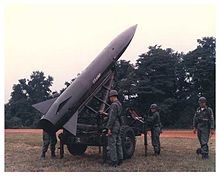 Throughout most of the Cold War, the United States maintained some 5,000 so-called tactical nuclear weapons in Europe, including land mines, artillery shells, and bombs on fighter-bombers. The rationale for their presence–let alone their very existence–was always dubious at best. In a daring move of startling vision, former president George H.W. Bush unilaterally withdrew almost all of them, leaving just a couple of hundred. Evidently the remaining ones were meant to play a largely symbolic role, a kind of “nuclear booby trap” to hold the Atlantic alliance together, as Pavel Podvig has put it.
Throughout most of the Cold War, the United States maintained some 5,000 so-called tactical nuclear weapons in Europe, including land mines, artillery shells, and bombs on fighter-bombers. The rationale for their presence–let alone their very existence–was always dubious at best. In a daring move of startling vision, former president George H.W. Bush unilaterally withdrew almost all of them, leaving just a couple of hundred. Evidently the remaining ones were meant to play a largely symbolic role, a kind of “nuclear booby trap” to hold the Atlantic alliance together, as Pavel Podvig has put it.
Increasingly, it seems that was the wrong kind of symbolism. A few years back, several of the five countries in which tactical nuclear weapons are based began to call for their removal, but the Obama administration resisted pressure, arguing any such move should be contingent on Russia’s reducing, relocating or even eliminating its arsenal of tac nukes, estimated at about 2,000 in various states of readiness.
Now, a group of arms control specialists have written to the NATO secretary general with some ideas about how the alliance could reduce reliance on nuclear weapons so as to strengthen global nonproliferation efforts and send “a strong signal that the alliance is serious about creating the conditions for a world without nuclear weapons.” The letter’s 25 signatories include many very well known old-timers as well as almost equally well known newcomers, giving it a multi-generational feel.
Dated July 12, the letter calls upon NATO to clearly communicate that tactical nuclear weapons are not required to meet external threats, including any possible threat from Russia. At the same time, it voices support for NATO’s 2010 Strategic Concept, calling on Russia to be more open about its tac nuke deployments and to relocate the weapons away from the European frontiers. It says that the U.S. tac nukes serve no military purpose that can’t be met equally by European strategic nuclear and conventional forces; accordingly, it says there’s no need to modernize the B61 nuclear warheads stationed in Europe. NATO should indicate that the “fundamental” purpose of its nuclear arsenals is to deter nuclear attack, promise not to use nuclear weapons against non-nuclear states, and reiterate that European missile defense plans do not in any way target Russia.
The letter is a welcome and useful development, but it will be best, in my opinion, not to have excessive expectations about Russia’s response. With the shift of the overall East-West military balance decisively in favor of NATO, Russia increasingly emphasizes nuclear weapons not merely as a deterrent against nuclear attack but against conventional attack as well. (Thus, the situation is a mirror image of what it was in the Cold War.) Given the near universal feeling in Russia that the forward expansion of NATO and of the European Union into eastern Europe violated the spirit of the agreements that ended the Cold War and reunited Germany, it’s improbable that any Russian leadership would look generously at offers to talk about tac nukes or further declarations of good will about missile defenses.
It would be better, in the spirit of George H. W. Bush, to just eliminate the remaining tac nukes unilaterally and revisit the question of whether short-range missile defenses are really necessary. Surely, in the improved atmosphere such moves would bring, reciprocal gestures eventually would be forthcoming.